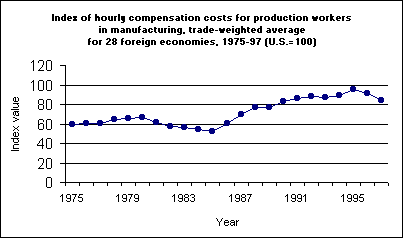An official website of the United States government
 United States Department of Labor
United States Department of Labor
The trade-weighted average hourly compensation costs for manufacturing production workers in 28 foreign economies was 16 percent lower than similar costs in the United States in 1997. This gap was only 5 percent in 1995 and 9 percent in 1996. Overall, the average cost level for the 28 foreign economies studied decreased 2.4 percent.

[Chart data—TXT]
The largest cost reductions among the countries studied occurred in Europe. Translated into dollars, hourly compensation costs in Switzerland fell by nearly 15 percent and five other European economies had declines of over 10 percent in 1997. Despite these declines, manufacturing compensation costs in Europe tended to be higher. For example, even after falling by 11 percent over the year, Germany’s compensation costs ($28.28) continued to be highest among the countries studied and was more than 1 1/2 times the U.S. level of $18.24.
In Japan, hourly compensation costs in manufacturing dropped by 7.4 percent in 1997, following a 12.2 percent decline the year before. This left the Japanese cost level ($19.37) just 6 percent above the U.S.
Among the newly industrialized economies (NIEs) of Asia—Hong Kong, Korea, Singapore, and Taiwan—trade-weighted manufacturing compensation costs measured in U.S. dollars declined for the first time in the history of the series, which began in 1975. The decrease of 2.5 percent brought trade-weighted average costs in the Asian NIEs to 36 percent of the U.S. cost level.
These data are products of the BLS Foreign Labor Statistics program. For additional information, see news release USDL 98-376, International Comparisons of Hourly Compensation Costs for Production Workers in Manufacturing, 1997.
Bureau of Labor Statistics, U.S. Department of Labor, The Economics Daily, International average of factory worker compensation falls relative to U.S. at https://www.bls.gov/opub/ted/1998/oct/wk3/art04.htm (visited July 12, 2025).

